Menu
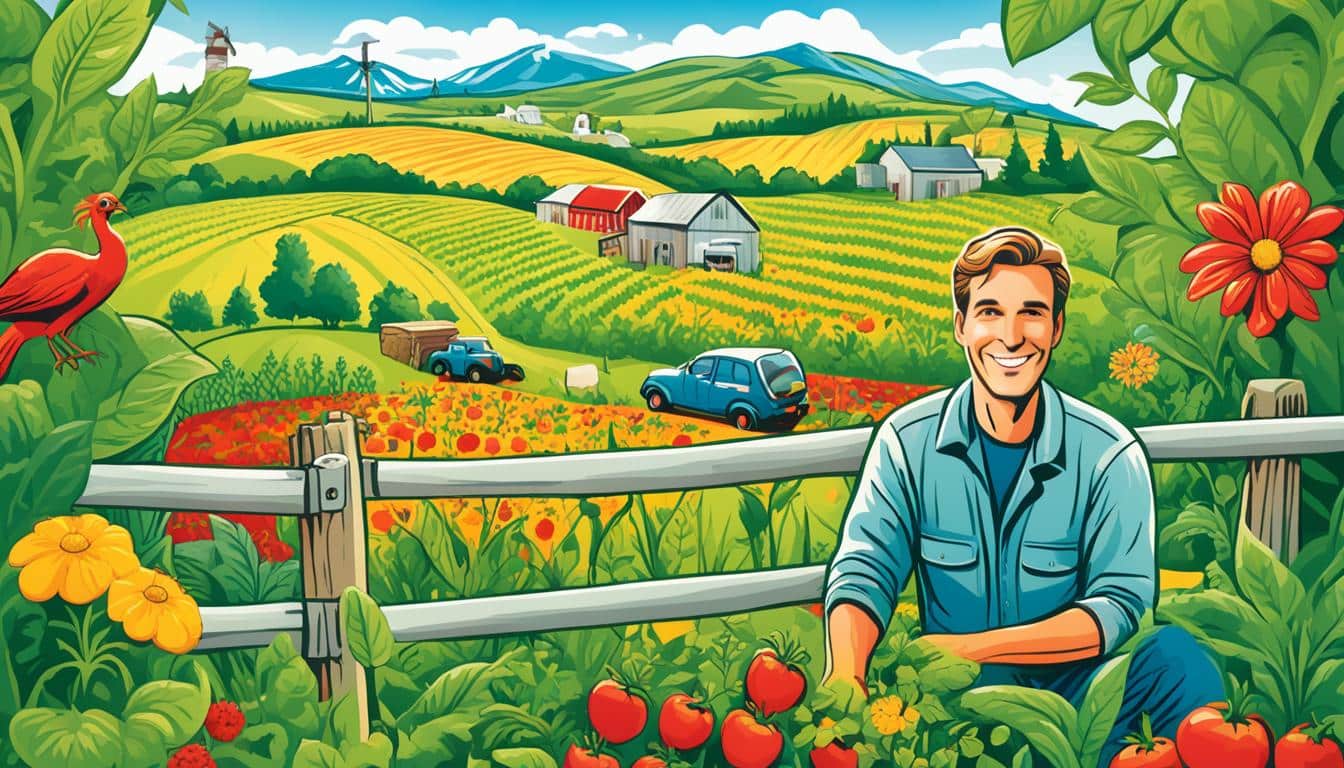
Our earth is a wonder, balancing life’s intricate needs. Despite their importance, today’s farming methods are a huge danger to the variety of life around us. Saving farm biodiversity is crucial for our future.
The mix of plants, animals, and fungi on farms is key to our food. But the ways we farm often harm these vital ecosystems. This damage leads to loss of homes for wildlife, drops in species numbers, and a changing climate.
We’re at a turning point, facing big challenges that need urgent solutions. Small farmers who use sustainable ways of farming are our heroes. They help protect nature, reduce pollution, and save unique plant types from the impacts of climate change.
Farm biodiversity is the many different types of life on farms. This includes plants, animals, and the places they live. Sadly, recent times have seen a big drop in the numbers of various species around the world. This is mainly due to destroying their habitats. Farming also adds stress through pollution and damaging local ecosystems.
Keeping farms diverse is important for the planet. For example, growing cover crops helps birds and insects find homes. In the U.S., over 1,900 farmers are using more cover crops thanks to Project O.S.C.A.R. They learn how cover crops help by joining this initiative. It’s happening in many countries to improve farm biodiversity.
Farming also affects our climate. It makes up about 13% of all pollution. But, using less harsh methods, like conservation tillage, can help. For example, traditional tillage uses a lot of fuel. It uses 9.1 liters for every hectare, while conservation tillage needs less, around 3 liters. So, this way of farming is better for the environment.
Protect nature is also vital for keeping our world healthy. By 2050, without serious action, we might lose services nature provides. This could cost the world a lot of money. But with farming practices that care for nature, we can prevent a big economic loss.
| Key Aspect | Impact |
|---|---|
| Traditional Tillage Fuel Usage | 9.1 liters per hectare |
| Conservation Tillage Fuel Usage | Less than 3 liters per hectare |
| Agriculture’s Carbon Footprint | 13% of global emissions |
| Cover Crop Adoption | 30% annual increase among 1,900 U.S. farmers |
| Value of Pollinator Services | €120 billion per year |
Knowing how farming affects biodiversity is key to making things better. By understanding this, we can protect our farms and their health. It’s all about long-term care and making sure agriculture is sustainable.
It’s key to protect farm biodiversity to keep vital ecosystem services going. These include things like helping crops grow, keeping pests in check, and maintaining rich soil. They’re all crucial for both sustainable farming and the health of what we eat.
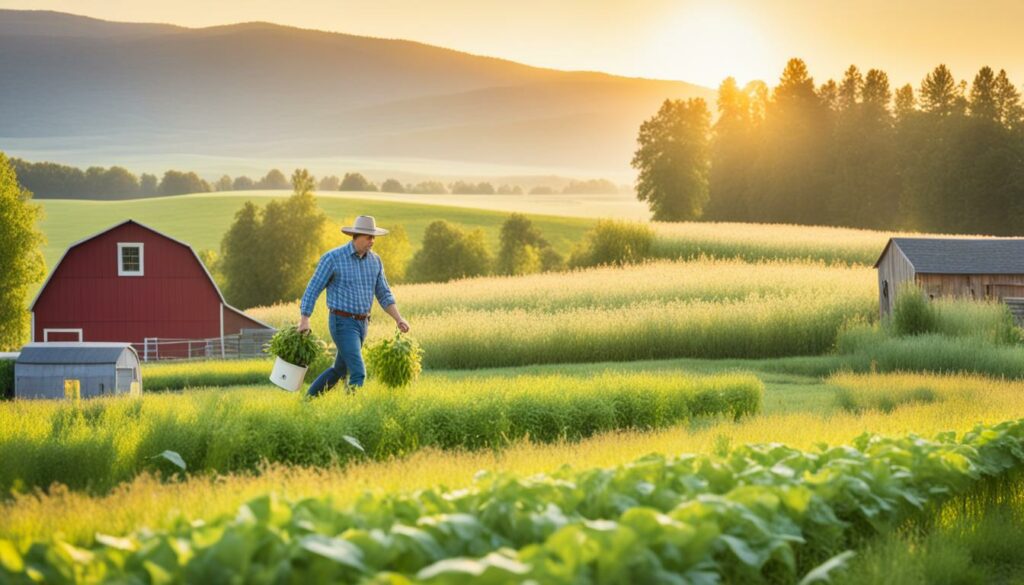
Diversified farms are great at boosting biodiversity in agriculture. Costa Rica, for example, saw its forests grow from 40% to nearly 60% in cover. This happened thanks to paying for ecosystem services.
This programme also helped bird numbers stay steady. It shows how farming can be good for nature and how nature helps us back.
About three-quarters of the world’s crops need pollinators. This fact alone shows why it’s vital to keep pollinator homes safe. Wild honeybees are down by a quarter since 1990. This is why we must farm in ways that help bees and others thrive.
Biodiversity loss is a huge worry for the world, ranking in the top five risks. Keeping the planet’s variety of life rich is very important.
Keeping farming sustainable is a must for a steady food supply. North America has seen bird numbers drop by 29% since 1970. This shows the harsh impact of heavy farming and loss of homes.
Habitat conservation on farms is a big help. It brings back birds that love forest areas. And setting some farm areas aside for wildlife can help crops grow better too.
Championing eco-friendly farming and biodiversity in fields is crucial. Doing this can lift up services that feed us. Efforts in forest conservation, like those in Costa Rica, show how this can work well.
It’s essential to balance agricultural land use with preserving habitats to keep farm biodiversity. Farming has become more intense, causing a loss of habitats and threatening many species. We must focus on conserving habitats to stop this.
Wildlife corridors are paths that join up isolated habitats. They help species move, find food, and have babies safely. In 1996, the US Department of Agriculture found that farming activities affected 46% of threatened or endangered species. Building wildlife corridors helps lessen these harmful impacts.
Keeping natural habitats in and around farms supports a variety of life and stops species from dying out. Less than 5% of the US doesn’t have roads but is wild. These areas are often alone. We should protect big, connected habitats more and use gentler farming methods. Doing this helps save animals like the western meadowlark, whose numbers have dropped by 90% in Wisconsin since the ’60s.
Also, we must deal with agricultural runoff, which has harmed 60% of US rivers. Waste from animal farms is much more than human waste and pollutes rivers and underground water. We need to farm sustainably and back local farms. This would help a lot in saving habitats and supporting the local community.
The importance of eco-friendly farming is growing. We need methods that are good for crops and the planet. Organic farming techniques are a key part. They focus on using natural ways and less chemicals, helping plants and animals thrive.
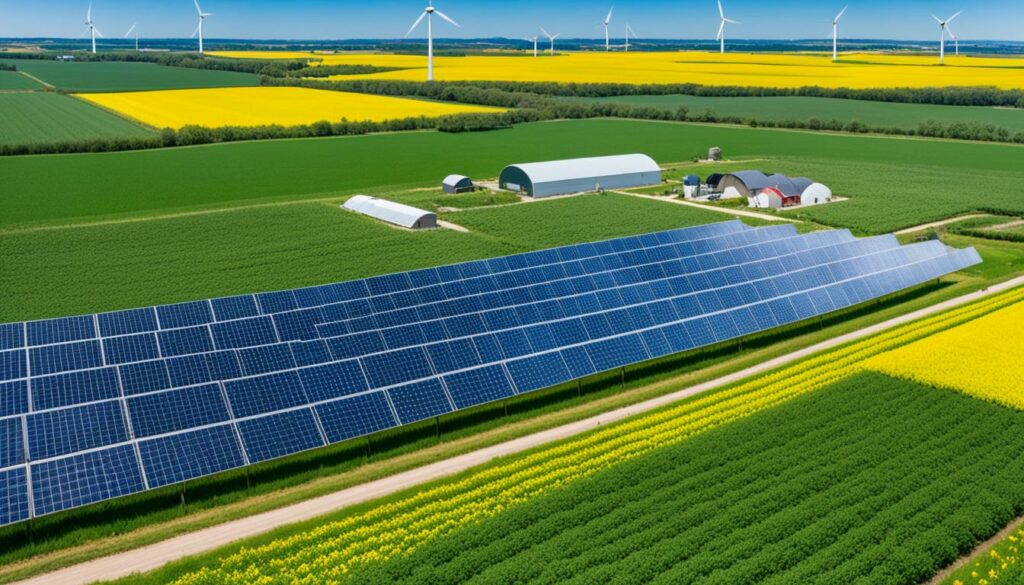
Research shows that using more than one eco-friendly method can really help the earth.
Adding animals to farms can make them work better and earn more money. Organic farming also makes the soil healthier. This helps keep water clean and stop pollution.
Growing trees and bushes among crops can bring in extra money. It’s good for the earth too. These methods aim to make farms work well without hurting the environment.
| Method | Benefit |
|---|---|
| Crop Variety | Enhanced soil health and pest control |
| Cover Crops | Prevents erosion, replenishes soil nutrients, reduces fertilizers |
| No-Till Methods | Mitigates erosion, improves soil health |
| Integrated Pest Management | Reduces reliance on chemical pesticides |
| Livestock Integration | Increases efficiency and profitability |
Looking after wild areas on farms is key too. It stops soil from being washed away into water and helps more plants and animals live. Changing to eco-friendly ways is really important. It helps keep the natural world in balance.
Sustainable farming practices help keep our planet healthy. They support the balance of nature and help crops grow for many years. These methods are good not just for the planet but for the many plant and animal species living here. Scientists think there are over 8.7 million different species on Earth! So, it’s very important to farm in ways that protect our environment.
Preserving grasslands is vital. In the US, areas like the tallgrass prairie used to cover 170 million acres. But, from 2015 to 2016, 2.5 million acres were turned into farmland. This change affects not only plants and animals but also the way soil and water behave.
Encouraging different plants and animals in farming can help fight against pollution. Agricultural practices are the main cause of deforestation, which harms many plant and animal species. The Amazon rainforest is a key example, as it’s home to a quarter of the world’s land species.
Using fewer chemicals and growing more varied crops supports life in the soil. It also helps stop pests and diseases without having to use harmful chemicals. This makes farms more productive and helps them last longer.
Here are some numbers to think about:
| Issue | Impact |
|---|---|
| Deforestation by agriculture | 80% worldwide |
| Permanent deforestation | Over 100,000 square miles annually |
| Monarch pollinator population decline | 70% in recent decades |
| Freshwater usage in agriculture | 70% of human-dedicated resources |
With more people and a bigger appetite for meat, it’s key to farm in ways that don’t hurt the Earth. We need to manage farms carefully to keep the environment healthy for all species.
In the end, sustainable farming isn’t a choice. It’s a must for the future of our food and to protect the wide variety of life on Earth.
Choosing organic farming is crucial for our planet’s health. It helps keep ecosystems safe and ensures farming can last a long time. These ways shun chemicals, using natural methods that help the earth and increase plant and animal variety.
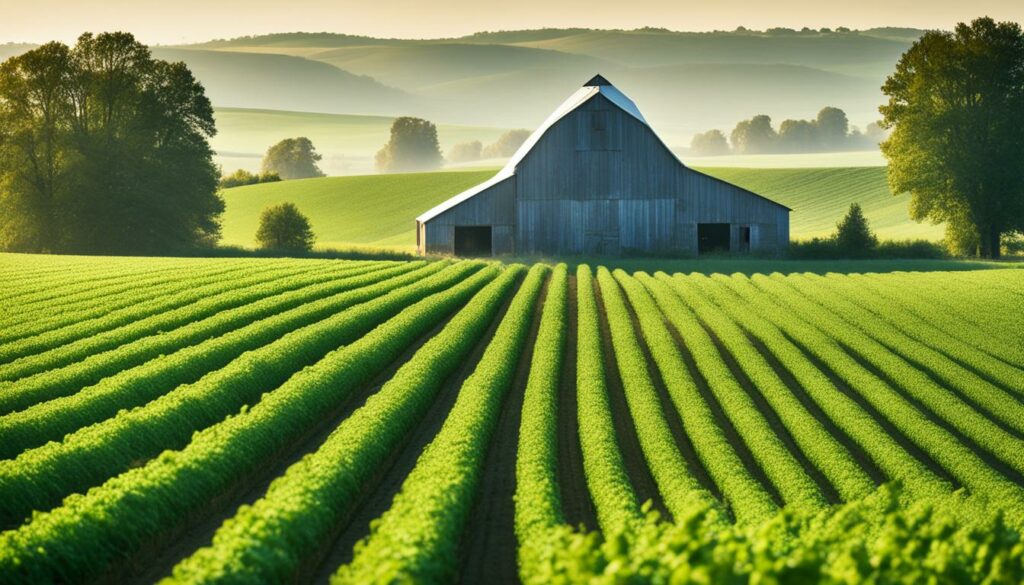
Organic farming says no to fake inputs. Without manmade pesticides and fertilisers, the risk of harming soil, water, and air is lower. It’s not just about what’s not used but about using nature’s way to keep the environment in harmony. Organic farms are known to attract more types of pollinators, which is good for the planet (Holzschuh et al., 2008; Gabriel & Tscharntke, 2007).
Keeping soil healthy is key in organic farming. Strong soil helps plants grow well and is the base for farming year after year. Practices like composting, changing what’s planted, and using covers on the ground boost soil health. These steps also make soil more resistant to harm from diseases and bugs. Over time, tests show soil in these farms stays in better shape (Siegrist et al., 1998).
| Advantages of Organic Farming | Conventional Farming Challenges |
|---|---|
| Promotes biodiversity | Habitat destruction |
| Improves soil health | Soil degradation |
| Enhances pollinator diversity | Pollinator decline |
| Reduces chemical contamination | High pesticide usage |
In conclusion, organic farming is a better way to farm. It avoids harmful chemicals and keeps the soil strong. This kind of farming is good for nature, supports diverse life forms, and follows the ideas of taking care of the earth. With these methods, farming can make the planet and our food supply healthier.
Promoting biodiversity in farming is key to keeping the world in balance and helping crops deal with hard times. It means using many ways to bring more life into farms. This helps farms last longer and handle tough environmental challenges better.
Growing lots of different crops is crucial for boosting biodiversity in farming. It keeps the land steady, nourishes the soil, and welcomes a bunch of wildlife. For example, having crops that live for many years can house bees and bugs that help fight off pests. This cuts down on harmful chemical use, making farms safer for everyone.
Adding trees to farms, known as agroforestry, is a big deal for biodiversity. It creates many different levels of life, helping all kinds of plants and animals thrive. This also stops soil from washing away, helps keep water in the ground, and traps carbon, making farming more sustainable. Agroforestry is a win-win: it’s good for nature, and it helps farms deal with the changing climate.
More than 1.1 billion people live in biodiversity hotspots, mostly dependent on agriculture. Hence, integrating biodiversity-promoting practices is crucial for their sustenance.
Using these methods shows how important biodiversity is in farming. They help keep farms going without harming the environment.
Protecting farm biodiversity is key to keeping our ecosystems healthy. It also helps many species survive the impact of farming. With about one million species facing extinction, conservation is vital. For example, North American bird populations have dropped by 29 percent since 1970.
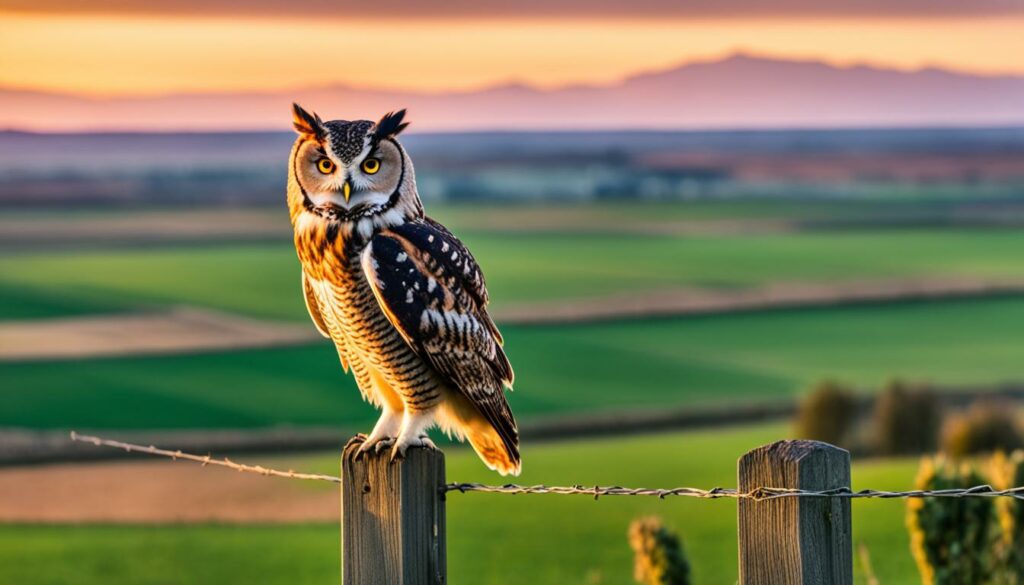
In the United States, more than 50 important species are at risk, including vital pollinators. Since 1990, the number of wild honeybees has fallen by 25 percent. This shows we need better ways to protect biodiversity on farms. One success story is the increase of 70-75 percent in bobwhite breeding densities in 14 states. This is thanks to wildlife-friendly farming methods.
Setting up wildlife corridors and saving natural habitats helps protect animals. It’s clear that keeping habitats intact helps both endangered and key animal species. These include those critical to their ecosystems.
Looking after livestock and their grazing is also crucial. It’s essential for creating a good environment for wildlife. Farms that work to be more diverse see many benefits. They enjoy better soil, help capture carbon, and make their whole ecosystem stronger.
In the U.S., 77 percent of non-federal rangelands are in good shape. When farmers use regenerative methods, they can cut U.S. agriculture’s carbon impact by over 85 percent. This shows how vital wildlife conservation on farms is.
One example of success is a 59 percent jump in wild trout in Montana. This was thanks to focused conservation efforts. It shows that nature-friendly farming not only helps the environment but also offers broader sustainability benefits.
Keeping natural habitats helps different species survive in farm areas. In Costa Rica, they’ve done great work. By mixing crops and leaving some forest untouched, they have helped many birds stay alive for 18 years.
This shows how crucial agriculture conservation is. A study looked at bird numbers in different places. It found that forests and places with a lot of farming were losing the most birds.
Many of the foods we need come from plants that need help from small creatures like bees. This means we must protect plants and animals where we grow food. Costa Rica has done something amazing. It started a project to pay for taking care of forests. Since then, more trees are growing, and now nearly 60% of the country is covered in forests.
Taking care of nature and not just growing food is important. This way, farmers can help save birds and other animals. They are paid for looking after the land well. This also helps our food grow better.
“Preserving existing natural habitats is crucial to harmoniously balancing the demands of agriculture and the preservation of wildlife,” highlights Dr Sanchez, an expert in biodiversity conservation.
Ecolabels are key for those who want to back eco-friendly farming. They help consumers choose products that support biodiversity. Take the Wisconsin Healthy Grown potato ecolabel, for example. It was started in 2000 by the WPVGA. This group joined forces with potato farmers, researchers, and NGOs. Together they showed the power of ecolabels in promoting eco-friendly and sustainable farming.
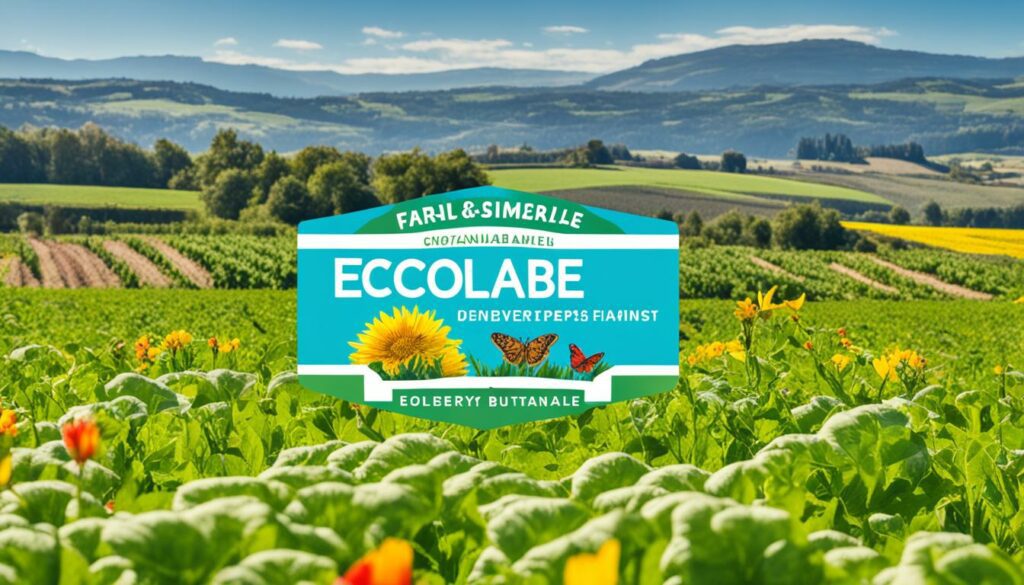
Christian Ziegler’s work shows how picking ecolabelled products like USDA Organic helps our planet. The Wisconsin Healthy Grown ecolabel, to begin with, focused on reducing harmful pesticides. It looked at things like keeping an eye on pests, how to manage them, and the quality of soil and water. This shows their deep commitment to nature-friendly farming.
People who care about the earth are happy to pay more for eco-friendly items. WPVGA’s research found this out. It pushed farmers to get their products certified with ecolabels. Choosing these certified products means supporting farming that protects wildlife. Trustworthy ecolabels also help buyers and sellers know about a product’s eco-effect. This lets buyers pick with confidence, knowing they are choosing the better option for the planet.
Knowing what ecolabels stand for helps us make smart shopping choices. For example, the Healthy Grown ecolabel focuses on keeping land healthy. This includes actions like bringing back native prairies and woodlands. Research shows that these ecolabels can help farms do their part in saving wildlife. This is crucial with the big risks some modern farming methods pose.
Eco-labels serve as the bridge between conscientious consumers and sustainable farming practices, fostering an environment where conservation efforts and agriculture can coexist harmoniously.
Good policies and laws are crucial in safeguarding farm life diversity. They set out clear rules and help farmers use sustainable methods. This keeps our farms healthy for the future.
The FAO and other big groups say we need to farm in ways that last. They point out plans that focus on keeping forests and farm lands alive. In the USA, the Agriculture Department has rules. It says farms that produce organically must keep our natural world the same or better, according to law 7 CFR 205.200.
Getting rewards helps farmers choose green farming methods. In the years 2014-20, the CAP paid farmers to look after grasslands and grow different crops. The CAP’s next plan, for 2023-27, offers more help and rules to support nature-friendly farming. It aims to cut down harmful pesticides and nutrients by half.
Since 2009, the National Organic Standards Board has also pushed for more protection and learning about our world. Organic farms enjoy lower costs for fighting pests, cleaner water, and help from pollinators. This shows how encouraging good behaviours can really help save our environment.
Being stewards of the land is key for farmers. How we farm affects biodiversity, which 70% of rural societies see as important. So, we need to farm in ways that keep our ecosystems healthy.
Over the years, using sustainable farming practices has helped a lot. For example, since 1982, soil erosion in the U.S. has fallen by 43%. Also, using almost 588 million gallons of recycled water a day shows we’re saving resources. This kind of farming helps both nature and our farms.
The FARM Environmental Stewardship Program found some great things. Life cycle studies from over 500 dairy farms show it takes much fewer resources to make food now. For example, making the same amount of chicken takes 75% fewer resources than 50 years ago.
Most farms are family-owned, showing many can do good environmental work. By caring for the land, farmers help keep our planet healthy. This is vital for animals, plants, and people. And it also helps fight against climate change.
But there’s a lot of false information out there about farming. Giving out the right info is important. It helps farmers do better with the environment. Joining programs like FARM’s Environmental Stewardship Version 2 can make a big difference. They get advice from many people, making the plans stronger.
Farmers who care for the land set a great example for the future. They show that growing food can be good for the planet, too. By using resources wisely and farming in a way that protects nature, we all win.
| Key Statistic | Details |
|---|---|
| Family-owned farms | 98% of farms are family-owned |
| Reduction in erosion | 43% decrease in wind and water erosion since 1982 |
| Resource efficiency | 75% fewer resources to produce chicken than 50 years ago |
| Water usage for milk | 65% less water and 90% less land for each gallon of milk |
| Recycled water daily | 587.76 million gallons used in agriculture |
| Dairy farm data | Data from over 500 dairy farms included in FARM program |
Climate change is a big threat to our wildlife, destroying natural habitats and risking the survival of many species. More than half of the world’s economic activity depends on nature. Currently, up to a million species face the risk of disappearing.
Some strategies can help, like changing how we farm, to lessen these impacts and make us more ready for change.
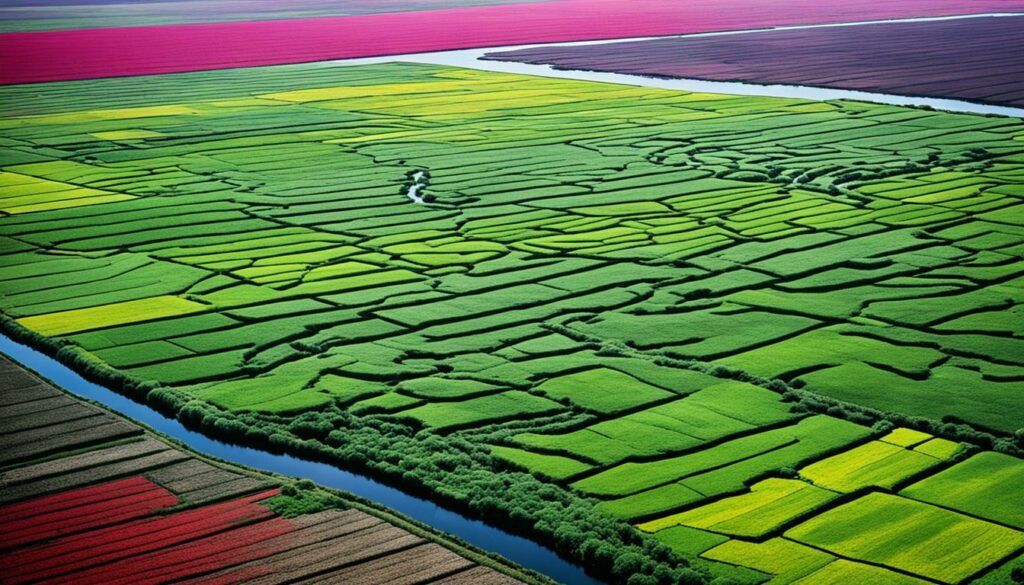
Changing how we farm helps tackle climate change’s effect on nature. This includes smart ways like those used in Chile for growing mussels. They help cut down on harmful gases and are better for the environment. In Samoa, focusing on more resilient crops and trees across 16,760 hectares has been a successful approach.
In Paraguay, working with the FAO, local communities are planting wild yerba mate trees. These trees help fight off climate-driven problems and also provide for people’s daily needs. This shows that local solutions can have a big positive impact.
Lessening the release of greenhouse gases is critical to protect wildlife. Areas like peatlands and mangroves are very good at capturing carbon. Peatlands, for example, store more carbon than all the world’s forests combined.
Mangroves in Cuba are a great example. They cover 5.1% of the country and play a vital role in shielding the coast. This shows how important it is to look after our natural environments. Nearly one-third of the needed emissions cuts in the next ten years could come from letting nature absorb more carbon. This is why it’s key to include these efforts in how we grow food and manage farms.
Keeping farm biodiversity safe is key for ecosystem stability and our food’s future. The rapid loss of nature worldwide shows how critical this is. Today, losing biodiversity is just as serious as not acting on climate change and facing extreme weather. These threats affect everyone on Earth greatly.
Almost a million out of the eight million known animals and plants could vanish. In North America, bird numbers are down by 29 percent since 1970. Similarly, wild honeybee counts have dropped by 25 percent since 1990. It’s up to us to keep these species from disappearing.
To protect the variety on farms, we need to farm in ways that don’t harm wild areas. Things like making paths for animals and plants to move through – like grassy banks and tree lines – keep homes safe for them. Also, by farming in friendlier ways, U.S. farms could help the planet a lot. They could trap enough carbon to make up for 85 percent of what they usually add to the air.
Also, farm areas that aren’t used much are key. Around 42 percent of these spots are crucial for many animals and plants. The U.S. is thinking about protecting more than 550 species, including over 50 that are important for pollinating plants. This could help us have enough food in the future.
It’s crucial to keep nature’s balance for people and animals to live well. By taking care of the land, like making sure wildlife has space, we’ve seen good changes. The number of certain birds and fish have gone up in places that took extra care of nature.
By looking after nature and saving farm variety, we can stop more species from disappearing. This will help us all have enough food and a healthy planet in the future.
Protecting farm biodiversity is crucial for many reasons. It isn’t just about taking care of our environment. It’s also about making sure we have enough food in the future.
The way we produce food today is harmful to our planet. For example, it creates almost a third of all the world’s greenhouse gas emissions. Farming takes up a lot of land, about half of the land that isn’t covered in ice. Since 1962, we’ve used a lot of land to grow crops and raise animals. This has caused many animal species to disappear forever.
It’s urgent that we start farming in a more sustainable way. By the year 2070, there will be 10.5 billion people on Earth needing food. This means we might need a lot more land for farming. This could harm big animals in Asia and Africa. It could also make the problems in our oceans and forests worse. Using more chemicals in farming adds to these issues.
Luckily, there are ways to farm that help biodiversity. For example, not using pesticides and working to help wildlife have good results. Planting trees, creating paths for animals, and using local plants can also help a lot. Bees, insects that eat pests, and other helpful creatures play a big part. They can make farming better without the need for lots of chemicals.
We all need to work together to use farming methods that are better for our planet. We need strong rules about how we farm to protect nature. Protecting the different plants and animals on farms helps us all. It makes our food systems stronger and keeps the Earth a good place to live. This way, we look after the Earth not just for us, but for the many people that will come after us.
Farm biodiversity is the variety of life on farms. This includes the plants, animals, and their habitats. It’s also about the different genetic types. Altogether, it’s a mix of life living and interacting together.
Keeping farm life diverse is crucial. It helps with growing crops, fighting pests, and keeping the soil rich. This all helps us have enough food.
Good farming that keeps nature healthy includes growing many types of plants. It also means using fewer chemicals. These help the environment and keep farming good for a long time.
Wildlife corridors are like natural paths for animals to travel. They help keep animal homes connected. This is important for their survival.
Eco-friendly farming is about doing less harm to nature while still being productive. It includes using less harmful chemicals, caring for the soil, and managing pests carefully.
Organic farming avoids harsh chemicals. It focuses on caring for the ecosystem and the soil. This way, it helps more kinds of plants and animals live together.
Having many different plants and growing trees alongside crops help. This creates spaces where lots of wildlife can live. It makes farms more like natural habitats.
Protecting wildlife on farms is vital for the environment. It helps keep the natural balance. It also makes farms more sustainable places to grow food.
Keeping natural areas near farms helps in many ways. It controls pests, keeps the ecosystem in balance, and supports farming without harming the environment.
Choosing products with labels like USDA Organic and Fair Trade helps. These standards mean the food was grown without harming nature. It supports good farming practices.
Laws and policies encourage farmers to protect nature while they farm. They give guidelines for doing farming that is good for the environment. This keeps the biodiversity healthy.
Environmental stewardship is about taking care of nature while farming. It’s using resources wisely and thinking about nature’s future. Farmers play a big part in keeping the land healthy.
Climate change is a big problem for nature. It pushes farmers to find new ways to farm that protect the environment. This is key for keeping farms and nature healthy.